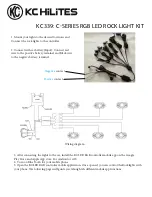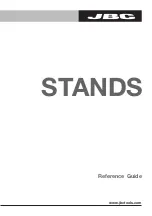
43
42
MANUAL FLASH (M)
AF Macro Zoom 3X-1X f/1.7-2.8 (Lens aperture range at 1X: f/5.6 - 54,
at 3X: f/6.7 - 64)
When Twin Flash Units are at Different Power Level Settings
The values given in the preceding tables for the twin flashes,
assume that both twin flash units are set at the same flash level.
When they are set to different flash power levels, the aperture
needed for correct exposure can be calculated using the following
equasion:
(A flash aperture)
2
+ (B flash aperture)
2
Aperture*
Example: using an AF 100mm f/2.8 Macro lens with a pair of twin flash
units with no arm. “A” twin flash is set at a power level of 1/8, “B” twin
flash unit is set at 1/16, and the magnification ratio is 1:1 (bold type val-
ues in the table on page 40).
19
2
+ 13
2
361 + 169
530
=
=
=
22
Aperture =
Therefore, in the above example, an aperture setting of f/22 will give
proper exposure.
The following adjustment must be made to the exposure when
using different film speeds or accesories.
When Using Film Other Than ISO 100, Or When Using the
Wide-Angle Adapter or Diffuser
Using the diagram at the left, moving one step
vertically is equal to a full-stop change. Moving
one step diagonally, is equal to a half-stop
change. Example: starting at f/8, if you decrease
the exposure by a full stop, you get f/11. If you
increase the exposure by a half stop, you get
f/6.7.
If you were using an AF 200mm f/4 Macro Apo G
lens, two twin flash units, no arm, a power level
of 1/4, magnification ratio of 1:1, and ISO 100
film, the calculated aperture would be f/32 (bold
type in the table on page 41). But with ISO 200
film and the diffuser, using the chart above, you
will see that you need to adjust the aperture by
+1.5 stops. The resulting aperture of f/19 is
required for a correct exposure.
* When both twin flash units are used.
3X
1X
Magnification Ratio
Power level
Ring flash
(1 ~ 4 lamps)
1/1
1/8
1/4
1/32
1/64
1/16
1/2
W/O Wide-angle
adapter or Diffuser
(Exposure adjustment)
With Wide-angle
adapter
(Exposure adjustment)
With Diffuser
(Exposure adjustment)
ISO 25
+2 Stop
+3.5 Stop
+4.5 Stop
ISO 50
+1 Stop
+2.5 Stop
+3.5 Stop
ISO 100
No change
+1.5 Stop
+2.5 Stop
ISO 200
–1 Stop
+0.5 Stop
+1.5 Stop
ISO 400
–2 Stop
–0.5 Stop
+0.5 Stop
ISO 800
–3 Stop
–1.5 Stop
–0.5 Stop
76
108
38
27
54
19
13
45
64
22
16
32
90
11
















































